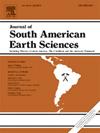Estimating long-term leaching of As, Pb, and Zn in old mine wastes from center of Mexico
IF 1.7
4区 地球科学
Q3 GEOSCIENCES, MULTIDISCIPLINARY
引用次数: 0
Abstract
The mining industry in Mexico has generated a large amount of waste containing potentially toxic elements that have been dumped directly on the ground for many years. Therefore, additional studies are needed to evaluate the environmental impact of these metals. This work performed dynamic leaching tests of potentially toxic elements from historical mining wastes from Monte de San Nicolás and Mineral de Peregrina in the Mining District of Guanajuato, Mexico. The EN 14405:2017 Standard was used L/S ratios at 0.1, 0.2, 0.5, 1, 2, 5, 10, and extended at L/S ratios, 13, 16 and 20. The studied elements were As, Pb, and Zn; the calculated mobility, or release, was determined using the equation proposed by the Dutch Building Materials Decree at liquid-to-solid ratios of 10 and 20. The pH of the tailings and the high percentages of carbonates indicate a low possibility of generating acid drainage. The As, Pb, and Zn cumulative release were greater at the Peregrina site with values of 0.904, 0.016, and 0.210 mg/kg respectively. The 100-year arsenic release estimate at the Peregrina site was 2186 mg/m2 at a liquid/solid ratio of 10 and 3408 mg/m2 at a liquid/solid ratio of 20, thus exceeding the Dutch decree limit in 15 and 10 years respectively.
求助全文
约1分钟内获得全文
求助全文
来源期刊

Journal of South American Earth Sciences
地学-地球科学综合
CiteScore
3.70
自引率
22.20%
发文量
364
审稿时长
6-12 weeks
期刊介绍:
Papers must have a regional appeal and should present work of more than local significance. Research papers dealing with the regional geology of South American cratons and mobile belts, within the following research fields:
-Economic geology, metallogenesis and hydrocarbon genesis and reservoirs.
-Geophysics, geochemistry, volcanology, igneous and metamorphic petrology.
-Tectonics, neo- and seismotectonics and geodynamic modeling.
-Geomorphology, geological hazards, environmental geology, climate change in America and Antarctica, and soil research.
-Stratigraphy, sedimentology, structure and basin evolution.
-Paleontology, paleoecology, paleoclimatology and Quaternary geology.
New developments in already established regional projects and new initiatives dealing with the geology of the continent will be summarized and presented on a regular basis. Short notes, discussions, book reviews and conference and workshop reports will also be included when relevant.
 求助内容:
求助内容: 应助结果提醒方式:
应助结果提醒方式:


